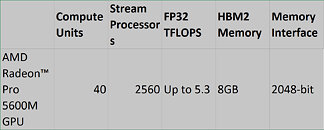Monday, June 15th 2020

New AMD Radeon Pro 5600M Mobile GPU Brings Desktop-Class Graphics Performance and Enhanced Power Efficiency to 16-inch MacBook Pro
AMD today announced availability of the new AMD Radeon Pro 5600M mobile GPU for the 16-inch MacBook Pro. Designed to deliver desktop-class graphics performance in an efficient mobile form factor, this new GPU powers computationally heavy workloads, enabling pro users to maximize productivity while on-the-go.
The AMD Radeon Pro 5600M GPU is built upon industry-leading 7 nm process technology and advanced AMD RDNA architecture to power a diverse range of pro applications, including video editing, color grading, application development, game creation and more. With 40 compute units and 8 GB of ultra-fast, low-power High Bandwidth Memory (HBM2), the AMD Radeon Pro 5600M GPU delivers superfast performance and excellent power efficiency in a single GPU package."More than ever, pro users require the freedom to create wherever their work takes them," said Scott Herkelman, corporate vice president and general manager, Graphics Business Unit at AMD. "With AMD RDNA architecture, the AMD Radeon Pro 5600M GPU offers the optimal combination of compute horsepower and power efficiency, providing an outstanding mobile graphics solution to power a wide range of demanding workloads on-the-go."
Key capabilities and features of the AMD Radeon Pro 5600M GPU include:
The AMD Radeon Pro 5600M GPU is built upon industry-leading 7 nm process technology and advanced AMD RDNA architecture to power a diverse range of pro applications, including video editing, color grading, application development, game creation and more. With 40 compute units and 8 GB of ultra-fast, low-power High Bandwidth Memory (HBM2), the AMD Radeon Pro 5600M GPU delivers superfast performance and excellent power efficiency in a single GPU package."More than ever, pro users require the freedom to create wherever their work takes them," said Scott Herkelman, corporate vice president and general manager, Graphics Business Unit at AMD. "With AMD RDNA architecture, the AMD Radeon Pro 5600M GPU offers the optimal combination of compute horsepower and power efficiency, providing an outstanding mobile graphics solution to power a wide range of demanding workloads on-the-go."
Key capabilities and features of the AMD Radeon Pro 5600M GPU include:
- Exceptional compute performance - Equipped with 40 compute units, the AMD Radeon Pro 5600M GPU delivers up to 5.3 TFLOPS of single-precision (FP32) floating point performance.
- HBM2 Memory - 8 GB of HBM2 with 394 GB/s bandwidth provides ultra-fast transfer speeds to power data-intensive pro applications.
- AMD RDNA architecture - AMD RDNA architecture delivers exceptional performance matched with remarkable power efficiency optimized for mobile computing platforms.


23 Comments on New AMD Radeon Pro 5600M Mobile GPU Brings Desktop-Class Graphics Performance and Enhanced Power Efficiency to 16-inch MacBook Pro
Edit: This also means that AMD was able to get the full Navi below 60 Watts as the MBP complete system tops out around 100 W.
At least we're finally at a place where desktop GPUs are power-efficient enough to be put into laptops as-is, with nothing more than a downclock.
Usually it's like same SP count = same model number. Or worse.
On most basic, simplified level it's Navi 10 with GDDR6 memory controllers switched to HBM2.
AMD Radeon Pro 5600M - 2560SP; Turbo 1035Mhz; 5300 GFlops; 50W TDP
AMD Radeon Pro 5500M - 1536SP; Turbo 1300Mhz; 4000 GFlops; 50W TDP
It has more CU, but also lower clocks and more efficient HBM2, so 50W TDP could be enough without too much throttling.
sadly amd dont have more products with HBM2 in desktop (RX 5500 with HBM2 could be have very interesting TDP)
:)
Also, the next generation consoles probably aren’t going to be massive power consumers, as that makes it really hard to drive down complexity and cost over time, which is usually a major goal for margins and adoption rate. The PS5 is packing a GPU that hits 2.23GHz. If PS4 Pro or XoX are any indication, I doubt Sony is letting that custom chip exceed 200W. The PS4 Pro could barely pull 150W from the wall socket, so the custom chip was even less than that.
Edit,
Well, the other article suggests it's around 1.0GHz. A little disappointing, but maybe it met Apple's ask. :(
Next gen consoles are using architecture which is 50%+ more power efficient, this is RDNA1, not RDNA2 like consoles.
Run "hotter" because they are on the same die, so any GPU Core activity would likely heating up HBM stacks as well since both under the same base plate.
I did want a Nano with HBM but reading about heat issues and lack of overclocking, as well as power consumption deterred me.
I really hope these new cards have improved in those departments.
As for temperature, I never expected R9 Nano perform quite well with just single axial fan in constrained space ( ITX chassis ), 80°C in furmark is remarkable.
TDP is just 150W, right next to GTX 970 but with performance of GTX 980Ti. If you find thats too aggressive you can tune it down withOverdriveNTool.
This card is the third AMD card that excites me most, below ATI 9700 Pro and unlockable 5850 / 6950 of course :p
But since everything is on the same die, it's much easier to cool with a single copper base plate.